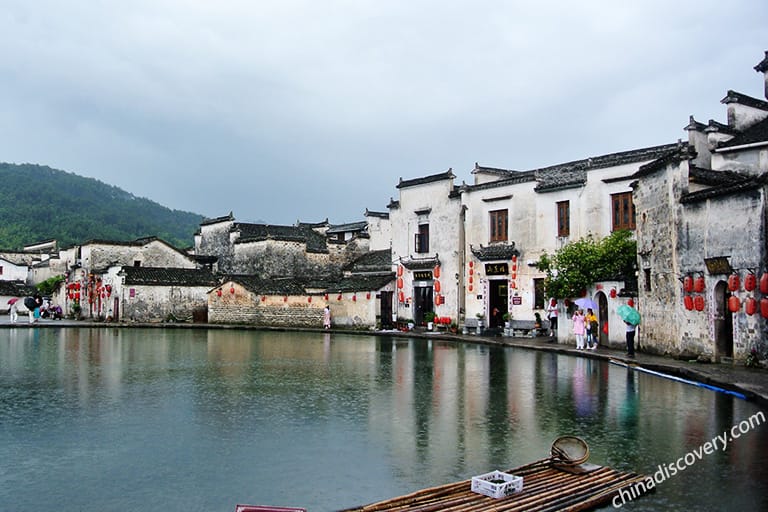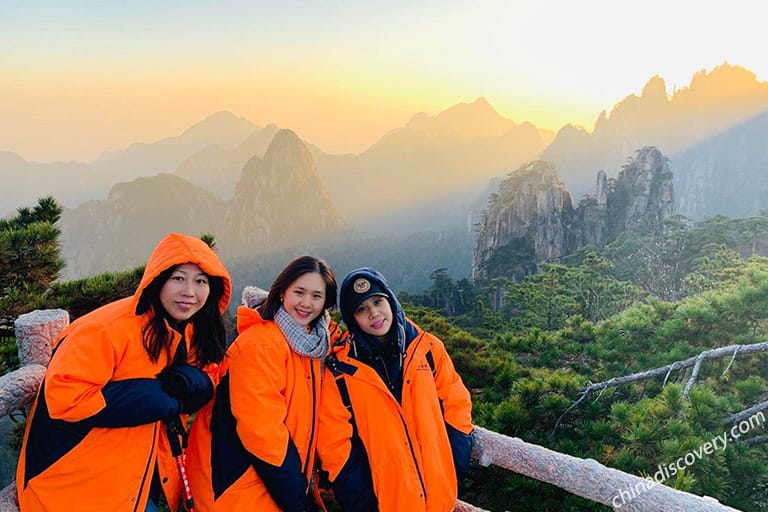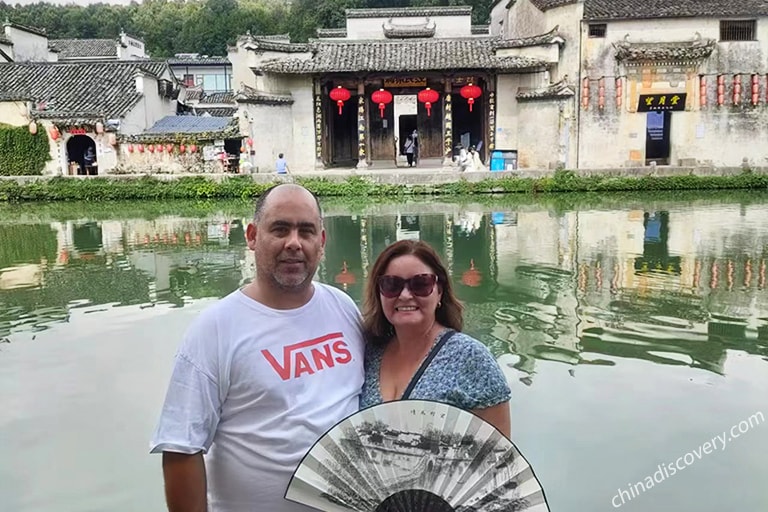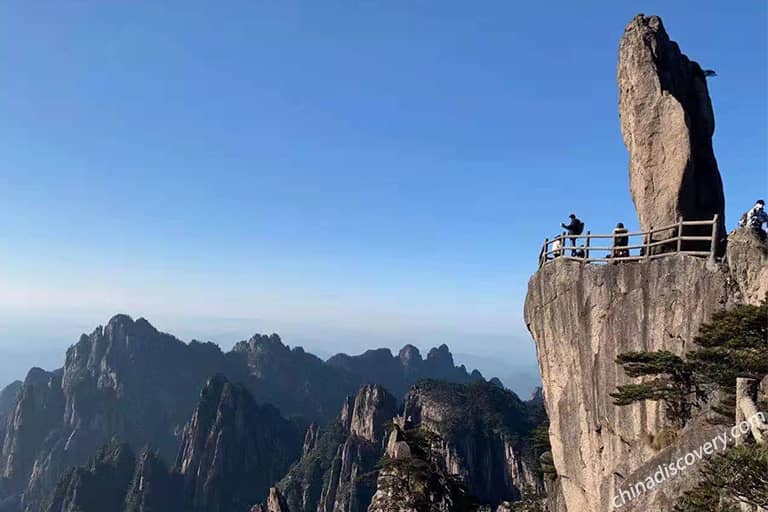Feng Shui Culture of Chengkan Ancient Village
The whole village of Chengkan is built according to the Bagua(Eight Trigrams) Feng Shui (Chinese geomancy) Theory from I Ching (the Book of Changes). Bagua includes eight interconnected symbols used to represent the eight (four pairs) fundamental elements in different aspects of the world, such as in nature, planet, personality, action. A pair refers to two seemingly opposite elements but somehow they are complementary and interdependent just like the light and the dark, the sun and the moon, and they are usually called Yang and Yin. It believes that when Yang and Yin are in balance, a supreme performance can be reached. Bagua has been applied to many fields in the history of China, including Feng Shui, according to which Chinese determine where to live and the layout of their residence.
Chengkan is naturally surrounded by 8 mountains in 8 directions with rivers flowing through the middle, which perfectly fits the ideas of Bagua. Cheng represents Yang, Kan represents Yin, and Chengkan together means the balance between man and nature. Therefore, Chengkan is also called "Bagua Village" or "Fengshui Village". Due to its special location and layout, it has always been regarded as the Fengshui treasure land. And the truth is that it indeed cultivated many famous people and officials in the history of China.
Outstanding Architectural Art in Chengkan Ancient Village
The several hundred ancient houses, ancestral halls, dwellings, pavilions, and bridges built in the Yuan(1271-1368), Ming(1368-1644) and Qing(1644-1911) Dynasties, and 22 national key protected cultural relics have won Chengkan the name of “the village with the largest number of Chinese national treasures”. The villagers pay much attention to the pass-down of traditions, and as the village name shows, they believe in living in harmony with the nature can help to form a balance and lead a well-off life. That’s why the village remains intact in hundreds of years. As a combined presentation of the profound understanding of the Eight Trigrams, the perfect practice of Fengshui culture, and the embodiment of Anhui classical art, Chengkan draws the attention of the tourists with its unique charm.
What to Do & See in Chengkan Ancient Village
As a village of nearly 2000 years’ history and unique Eight Trigrams layout, there is much to do and see in Chengkan. Here you can have an overview of the traditional Anhui-style architecture, experience the mysterious Feng Shui culture, take part in local activities in person.
Appreciate the Ancient Chinese Architectural Art
At the first sight, you may feel the architectures in Chengkan are in a neat and uniform Anhui style with high white walls and black roof-tiles. But watch closely, you will find that the walls, beams, doors, windows or other parts of the buildings are decorated with exquisite stone carvings, brick carvings, and wood carvings in different patterns such as clouds, lotus, birds, lions, monkeys. Inside the building, there is usually an open courtyard in the middle. The halls and rooms are connected by long corridors. The decorations and the overall layout of the house show the art taste of the owner and whether it is a well-off family. As Anhui people has the tradition to build houses after getting fame or money or to honor their ancestors, you can find many well-designed and valuable buildings here. Among them, Luo Dongshu Memorial Temple is undisputedly the grandest one.
Luo Dongshu Memorial Temple(贞靖罗东舒先生祠), built in the Jiajing period of the Ming Dynasty in 1539, is the essence of Chengkan scenic spot. This magnificent building featuring in “ancient, elegant, beautiful, and spacious” is reputed as the grandest memorial temple in China. It consists of four rows with each higher than the former one. It is a high-level Chinese ancient architecture representing the wealth of the family. The first three rows were built following the example of the Confucian Temple in Shandong Province, and the fourth following the Hall of Supreme Harmony in the Palace Museum. The fourth row, where the famous Baolun Pavilion(宝纶阁) stands, is the tallest and the most magnificent. The courtyard here is narrow and deep, which contrasts strongly with the spacious and bright one in the third row, making people feel a sense of dignity and sternness.
In Baolun Pavilion, there are 10 huge stone pillars along the corridor and 46 wooden pillars in the hall. The 26 black marble slabs in the front are carved with vivid birds and beasts patterns in different postures. People believe that they can keep the evil outside. The arches, sparrow braces, beam heads and other wooden components are exquisitely shaped in clouds, vases, flowers, etc. After over 400 years, the colored drawings on the roof beams still look bright and charming, and are known as "rare folk painting treasures in China". Anyone who sees the building will be amazed at its large scale and the exquisite construction techniques.
 Baolun Pavilion
Baolun Pavilion
Pass Through the Kan (Threshold) to Leave All the Misfortunes Behind
In Chinese, Kan means both threshold and misfortune. Therefore, people in Chengkan believe that when you pass through the threshold, you will leave all your misfortunes behind. The mysterious Kan-passing culture has been handed down from generation to generation for hundreds of years in Chengkan. The threshold(平安坎) is set near the Yongxing Lake with a stone mythical guardian beast sitting at each side.
Kan-passing is a must-do for all the tourists coming to Chengkan. Can’t wait to have a try? Don’t hurry, there is a certain code you need to follow. When stepping over the threshold, make sure that you are crossing from the middle and keep it in mind that men should lead with his left leg and women with her right leg. If you are here hoping for a promotion, or a safe and wealthy life, you are supposed to touch the tongue and then the head of the guardian beast piously. All finished, you will be blessed with all the good luck.
Cultivate Your Character at Zhongying Street(钟英街)
Zhongying means a well-endowed region that has brought forward men of talent. As the main street in Chengkan, Zhongying street is much wider than the other streets. It is also known as the official street because here resided many official families. In China, people pay much attention to the family traditions and think they have a great impact on the prosperity of the family. Therefore, they usually have a series of family mottos that inspire the family members to grow into upright, knowledgeable, and decent people. Standing on Zhongying Street, the archaic buildings on both sides seem to bring you back to the old days when the family mottos echo at your ear to help you cultivate your character. Above the street is Zhongying Tower which was used to tell the time and enjoy the cool. Spend some self-time here and see what insights you will get.
Have a Leisure Time at the Beautiful Yongxing Lake(永兴湖)
Once you step into Chengkan, you will find the beautiful Yongxing Lake waiting for you quietly. Situated at the entrance of Chengkan, Yongxing Lake is a bit like a miniature version of the South Lake in Hongcun, however with a much larger amount of lotuses. The villagers prefer to call it "Shuikou", which means the source of water, because all the water sources in the village converge here. As the Eight Diagrams theory puts it, water gathers money. Therefore, Yongxing Lake is also considered as a place where fortunes and blessings join together. Yongxing Lake is the most beautiful in July and August when all the lotuses blossom. Imagine how relaxing it would be to sit beside Yongxing Lake with the breeze puffing across the water.
Share the Happiness of Harvest in Autumn Sunning
Autumn sunning is a major feature of Chengkan village which can only be seen in autumn, usually from September to November. As there is no big sunning ground in Chengkan, the villagers are used to spreading the rice, corn, pepper, soybean and other crops harvested on the large square beside Yongxing Lake to dry them up. The activity usually occurs in autumn, so it is called Autumn Sunning. As the crops are in different colors, a pleasant and spectacular picture will be formed when the colorful crops are spread on the ground and over time it has become a unique landscape in Chengkan. Sometimes, special patterns such as the Chinese characters like “国庆” or the name of the village “呈坎” may be formed to celebrate the National day in October 1st. Chengkan at this time is usually overwhelmed by the happiness of harvest.
Recommended Visiting Route
Chengkan is not large and it would not take long (about 2 hours) to finish the tour. However, the 99 interwoven lanes seem to turn this small village into a maze and want to hold you back for a little longer. Therefore, we recommend you to travel with a tour guide so that you can learn more about the culture and history of the village and avoid getting lost. The following route marked in red in the map which covers most of the sites is only for your reference:
Entrance – Yongxing Lake (recommended photo-taking spot, especially in summer) - Lower house(下屋) (where you can find the I Ching Hall) – Yanyi Hall(燕翼堂) (an ancient house built in the Ming Dynasty) - Luo Chunfu House(罗纯夫宅)- Zhongying Tower (钟英楼) - Huanxiu Bridge (环秀桥)(the oldest building in the village, recommended photo-taking spot) - Changchun Commune (长春社) –Luo Dongshu Memorial Temple - exit.
How to Get to Chengkan Ancient Village
There are no flights or trains to Chengkan, you can only get there by car. As Chengkan is only about 30km away from Huangshan City and Huangshan City is easy to reach from other major cities in China like Shanghai, Hangzhou, Shenzhen, etc. We recommend you to get to Huangshan City first and then transfer to Chengkan.
There are direct buses between Chengkan and Huangshan Bus Station (Tunxi) every day. The ticket price is 10 CNY per person and the whole trip will last about 50 minutes. You can buy the tickets and check the latest timetable (not fixed) at the bus station.
If you want to save all the trouble and enjoy your trip to the fullest, you can choose one of our Chengkan tour packages which will provide you with cosy vehicls, professional guides and drivers. In this way, you can focus on the trip itself without worrying about other affairs like the routes, tickets, hotels, or transportations.
Best Time to Go
Chengkan is open to visitors all year round. Its annual average temperature is about 16°C. The hottest day can reach 40°C in August and the coldest (-6°C) is usually in January. Therefore, the best time to go is in the mild spring from March to May and the cool autumn from September to November(it is also the time you can enjoy the Autumn Sunning). But if you want to catch the beauty of the thriving lotuses in Yongxing Lake, you need to go there in July and be prepared for the heat.
Nearby Attractions
A half day is usually sufficient to well explore Chengkan. If you want to enrich your trip, here are some attractions nearby you can choose. Tangmo Village, only 13km away from Chengkan, is a village built after the the example of architectures in the Tang Dynasty(618-907). Then head to Tangyue Archway Complex, only 10 minutes’ drive from Tangmo. Here you can appreciate the largest archway complex in China, comprising 7 arches constructed in the Ming and Qing dynasties from 1420-1820. After that, walk for another 10 minutes, and you will find yourself at the largest bonsai garden of Huizhou School in China, Bao’s Family Garden. If you want to travel somewhere farther, the famous UNESCO World Heritage Site Huangshan Mountain and the picturesque Hongcun Ancient Village are also ideal options.
If you do not know how to schedule your trip, here is a classic 4 Days Huangshan to Huizhou Culture Exploration tour that covers all the attractions mentioned above for your reference. We are specialized in customized trips. If you are not satisfied with the plan, please send us your needs and requirements and we will offer you a personal tailor-made trip!
Which to Choose? Hongcun or Chengkan?
Hongcun lies about 70km to the west of Chengkan and it will take about 1.5 hours to drive there. Both Hongcun and Chengkan are ancient Hui-style villages, but Hongcun is more famous for its picturesque scenery and is reputed as “a village in the Chinese painting”. The Oscar movie Crouching Tiger, Hidden Dragon is also partly filmed here. Every year, thousands of tourists and photographers come here to have a view of its beauty. Compared with Hongcun, Chengkan is famous for its long history (dates back 900 years earlier than Hongcun), Bagua culture and unparalled architecture. Chengkan is a perfect choice for those who are looking for a place in real Anhui style but with less tourists. But As they are not very far, you can visit both villages if you are not in a hurry.
 Hongcun
Hongcun
Top Attractions in Huangshan
- Yellow Mountain (Mt. Huangshan)
- Hongcun Ancient Village
- Xidi Ancient Village
- Tunxi Ancient Street
- Hu Kaiwen Ink Factory
- Tangyue Memorial Archways
- Bao Family's Garden
- Huizhou Ancient City
- Chengkan Village
- Nanping Village
- Bishan Village
- Tachuan Village
- Lucun Village
- Guanlu Ancient Street
- Tangmo Ancient Village
- Mukeng Bamboo Forest
- Xinan River Landcape Gallery
- More Attractions in Huangshan
Extension Readings of Huangshan Travel Guide
- How to Plan Mount Huangshan Tour
- What to See on Yellow Mountain
- Activities in Huangshan
- Yellow Mountain Hotels
- Huangshan City Hotels
- Tangkou Hotels
- Huangshan Maps
- Best Time to Visit Huangshan
- Huangshan Transfer Guide
- What to Pack
- Huizhou Culture
- Huangshan Cuisine
- Huangshan Travel FAQs & Tips
- Huangshan Itinerary
- Huangshan Photo Gallery
- All Huangshan Travel Guide
Recommended Huangshan Tours
Top 3 Huangshan tours chosen by most customers to explore Huangshan in the best way. Check the detailed itinerary, or tailor your own trip now with us.

3 Days Huangshan Highlights Leisure Tour (Back Mountain + West Sea Grand Canyon)
Tunxi - Huangshan - Tunxi

4 Days Best Huangshan Tour with Hongcun & Xidi Ancient Villages
Tunxi - Huangshan Mountain - Hongcun - Xidi
Start planning your tailor-made holiday to China by contacting one of our specialists. Once inquired, you’ll get a response within 0.5~23.5 hours.
Customize a TripHave a question? Get answers from our travel experts or guests
- Your Question:
- Your Name:
- Your Email:
- Submit






















































